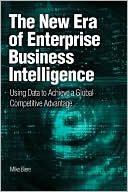Heads Up: Using Real-Time Business Information to Know First and Act Faster
Don't Prepare for Uncertainty-Drive It Out\ From "unexpected" earnings results to missed market opportunities to product launch disasters, we've come to accept uncertainty as an unavoidable fact of business life. But Kenneth G. McGee argues that even the worst business surprises rarely happen without warning-and that a few vital pieces of information can make all the difference in whether an event spells disaster, or opportunity.\ In Heads Up, McGee explains that success is not about...
Search in google:
McGee (a researcher and consultant) suggests that business should develop real-time systems to recognize and respond to unfolding events. He presents a set of methodologies for identifying important pieces of information, and then shows how to monitor, capture, and analyze that data in order to avoid disasters and find opportunities. Annotation ©2004 Book News, Inc., Portland, OR Soundview Executive Book Summaries According to Kenneth G. McGee, a group vice president and research fellow at the research and advisory firm Gartner Inc., even the worst business catastrophes rarely happen without warning. In Heads Up, McGee describes how managers can break the pervasive pattern of surprises that are often followed by desperate responses. Instead of trying to predict the future, McGee explains, managers need to master predicting the present - understanding what is happening right now and how these current events and outcomes will impact future success. The result: Potential disasters are turned into opportunities.Heads Up is about predicting the present. Predicting the present means taking raw empirical information, analyzing it, and determining its meaning and implications. However, managers don't need to know all the operational data to understand what the present situation is. Predicting the present is gathering enough information to answer the question, "Where are we right now in meeting our corporate goals?" By recognizing that there is always warning, and therefore monitoring progress on a daily basis, managers can turn what would have been surprises into a whole new world of opportunity. In the hands of a capable manager, current information about the state of the business always shows opportunities to improve good results or, at a minimum, to act to mitigate the impact of poor results. Therefore: If you acquire the ability to capture, receive, monitor and analyze information about certain events, when those events occur, you can predict the present. If you predict the present and identify the always-present early warnings of difficulties or successes, you will have identified an opportunity for better performance. If you take effective action based on these opportunities, you will be engaged in real-time opportunity detection. Real-time information is valuable because it gives the manager the most possible response options. Response options are actions that may be taken to mitigate the negative impacts or accentuate the positive aspects of an event before the impact of the event is felt. For example, if sales volumes are falling (event), a response option is to increase advertising to improve sales volume before quarterly revenue targets are missed (impact). As time passes after an event occurs, however, there are fewer and fewer responses that a manager can make to the event before the impact occurs. When discussing real-time information, the goal is to move the capture, monitoring, analysis and reporting steps not just earlier in the process, but into real time. Moving these steps into real time allows the most possible response options and enables choosing the best response from among them. A real-time response without due deliberation can sometimes be more harmful than the original situation. A "right-time" response can be far superior to a real-time response. Monitoring, capture, analysis and reporting of critical information must move to real time so predicting the present and real-time opportunity detection can take place. They will determine the "right time" for a response to achieve maximum positive results. To end business surprises, managers must receive a heads-up about the present - a few vital elements of data about what is happening right now in their business. Using this information, a manager can successfully understand the big picture at any given moment and predict the present. Using this real-time understanding of what is happening in his or her business, any manager has the chance to take action to prevent surprises and turn them into opportunities. Copyright © 2004 Soundview Executive Book Summaries
Introduction Section One: Ending Business Surprises Chapter OneTurning Business Disasters Into Opportunities Chapter Two Identifying and Justifying the Right Real Time Information Section Two: Real Time in the Real World Chapter Three Surprise Event: Missing the Warning Chapter Four Suspected Event: Reporting Too Late Chapter Five Surmounted Events: Getting it Right Section Three: From Real Time Opportunity Detection to the Real Time Enterprise Chapter Six Deploying Real Time Opportunity Detection Across the Enterprise Chapter Seven Solving the Challenges of Deploying Real Time Opportunity Chapter Eight The Future in a Real Time World Conclusion: The Time is Now
\ Soundview Executive Book SummariesAccording to Kenneth G. McGee, a group vice president and research fellow at the research and advisory firm Gartner Inc., even the worst business catastrophes rarely happen without warning. In Heads Up, McGee describes how managers can break the pervasive pattern of surprises that are often followed by desperate responses. Instead of trying to predict the future, McGee explains, managers need to master predicting the present - understanding what is happening right now and how these current events and outcomes will impact future success. The result: Potential disasters are turned into opportunities.\ Heads Up is about predicting the present. Predicting the present means taking raw empirical information, analyzing it, and determining its meaning and implications. However, managers don't need to know all the operational data to understand what the present situation is. Predicting the present is gathering enough information to answer the question, "Where are we right now in meeting our corporate goals?"\ By recognizing that there is always warning, and therefore monitoring progress on a daily basis, managers can turn what would have been surprises into a whole new world of opportunity.\ In the hands of a capable manager, current information about the state of the business always shows opportunities to improve good results or, at a minimum, to act to mitigate the impact of poor results. Therefore:\ \ If you acquire the ability to capture, receive, monitor and analyze information about certain events, when those events occur, you can predict the present.\ If you predict the present and identify the always-present early warnings of difficulties or successes, you will have identified an opportunity for better performance.\ If you take effective action based on these opportunities, you will be engaged in real-time opportunity detection.\ \ \ \ \ Real-time information is valuable because it gives the manager the most possible response options. Response options are actions that may be taken to mitigate the negative impacts or accentuate the positive aspects of an event before the impact of the event is felt. For example, if sales volumes are falling (event), a response option is to increase advertising to improve sales volume before quarterly revenue targets are missed (impact). As time passes after an event occurs, however, there are fewer and fewer responses that a manager can make to the event before the impact occurs.\ When discussing real-time information, the goal is to move the capture, monitoring, analysis and reporting steps not just earlier in the process, but into real time. Moving these steps into real time allows the most possible response options and enables choosing the best response from among them. A real-time response without due deliberation can sometimes be more harmful than the original situation. A "right-time" response can be far superior to a real-time response.\ Monitoring, capture, analysis and reporting of critical information must move to real time so predicting the present and real-time opportunity detection can take place. They will determine the "right time" for a response to achieve maximum positive results.\ To end business surprises, managers must receive a heads-up about the present - a few vital elements of data about what is happening right now in their business. Using this information, a manager can successfully understand the big picture at any given moment and predict the present. Using this real-time understanding of what is happening in his or her business, any manager has the chance to take action to prevent surprises and turn them into opportunities. Copyright © 2004 Soundview Executive Book Summaries\ \ \








